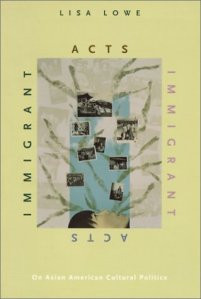Peer-Review: 0
Lowe, Lisa. “Heterogeneity, Hybridity, Multiplicity: Asian American Differences.” Immigrant Acts: On Asian American Cultural Politics. Durham and London: Duke University Press, 1996. 60-83. Print.
Lisa Lowe offers heterogeneity, hybridity, and multiplicity as tools to conceptualize “Asian American Differences” that challenge dominant discussions of authenticity and what it means to “be” an Asian American. She defines heterogeneity as the pluralism within the group of ‘Asian Americans’; hybridity as cultural intermixing due to (often involuntary) histories; and, multiplicity as the positioning of each individual along multiple axes of power (67). Lowe calls for an understanding of film and literature as agents in producing a pluralistic Asian American culture. Furthermore, she appropriates Gramsci’s notion of hegemony in understanding that while this culture includes dominant/racist representations of Asian/Americans, we could actively work to contest such images. Accordingly, Lowe offers examples from several literary works to illustrate the limits of positioning Asian Americans merely in terms of culture—through reinforcing narratives of East versus West in the form of parent-child tensions—as illustrative of this popular and problematic discourse in which critics must use as a point of departure (63).
In stressing cultural differences, Lisa Lowe intervenes in larger discourses within Asian American Studies that seek to examine an Asian American ‘identity’ which privileges commonality over differences. Centering a discourse around race, culture and/or ethnicity continually marginalizes examination of the means through which gender, class, sexuality and other differences intersect and complicate various experiences among Asian Americans. Thus, there are dangers in framing discussions around binaristic concepts such as ‘Old World,’ ‘New World,’ and other terms that seek to establish notions of concrete, static cultures based upon race. As her use of Angela Davis’s quote suggests, focus should be shifted away from people to the agenda: “basing the identity on politics rather than the politics on identity” (75). Lowe’s contribution is significant and transformative for imagining Asian American Studies as a critique that stresses the urgency of understanding past histories and experiences of exclusion while stressing the need to sustain this critique onto the present and into the future. Lisa Lowe’s work is also valuable for sustaining possibilities of coalition building with other scholars/activists while shifting away from identity politics.

